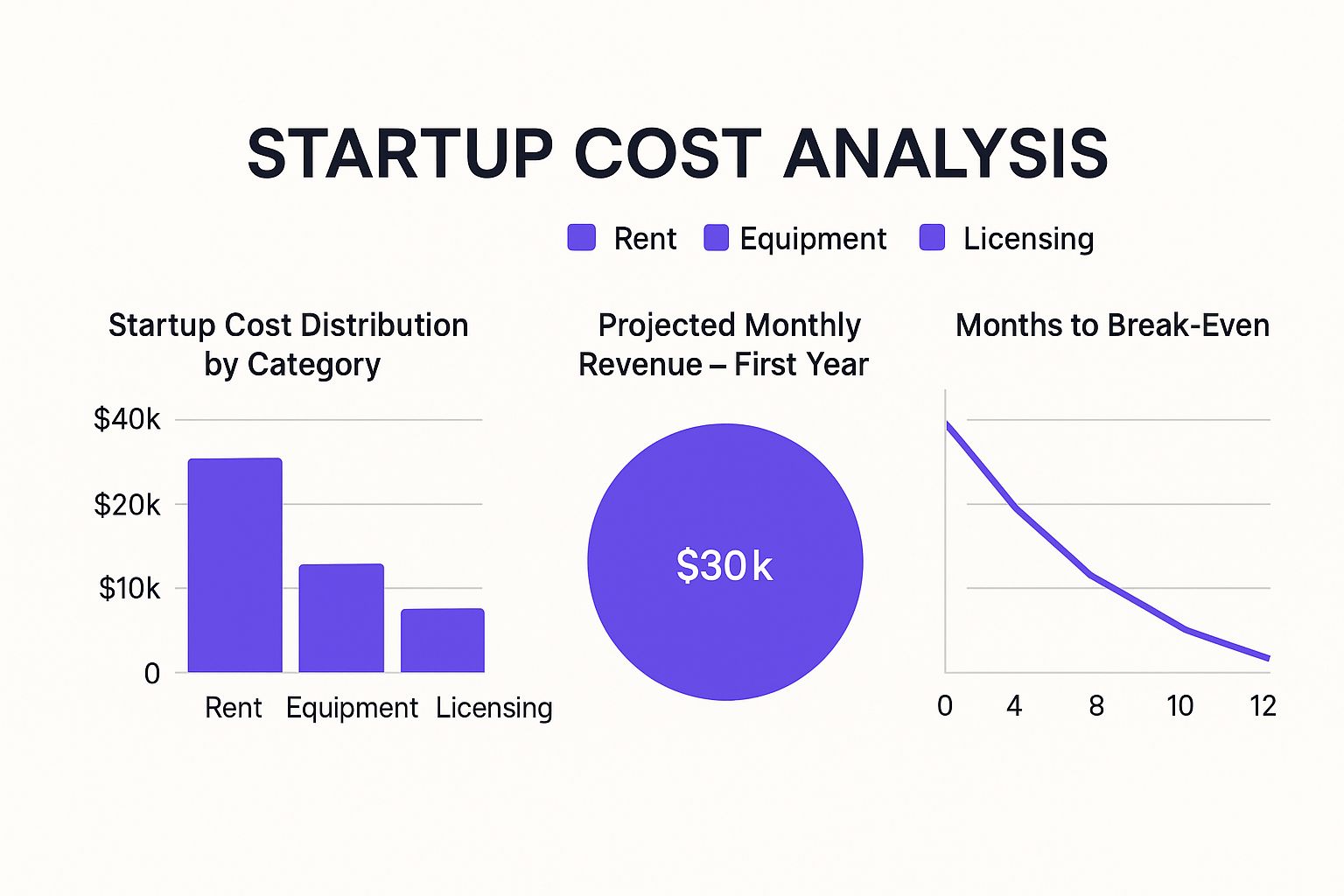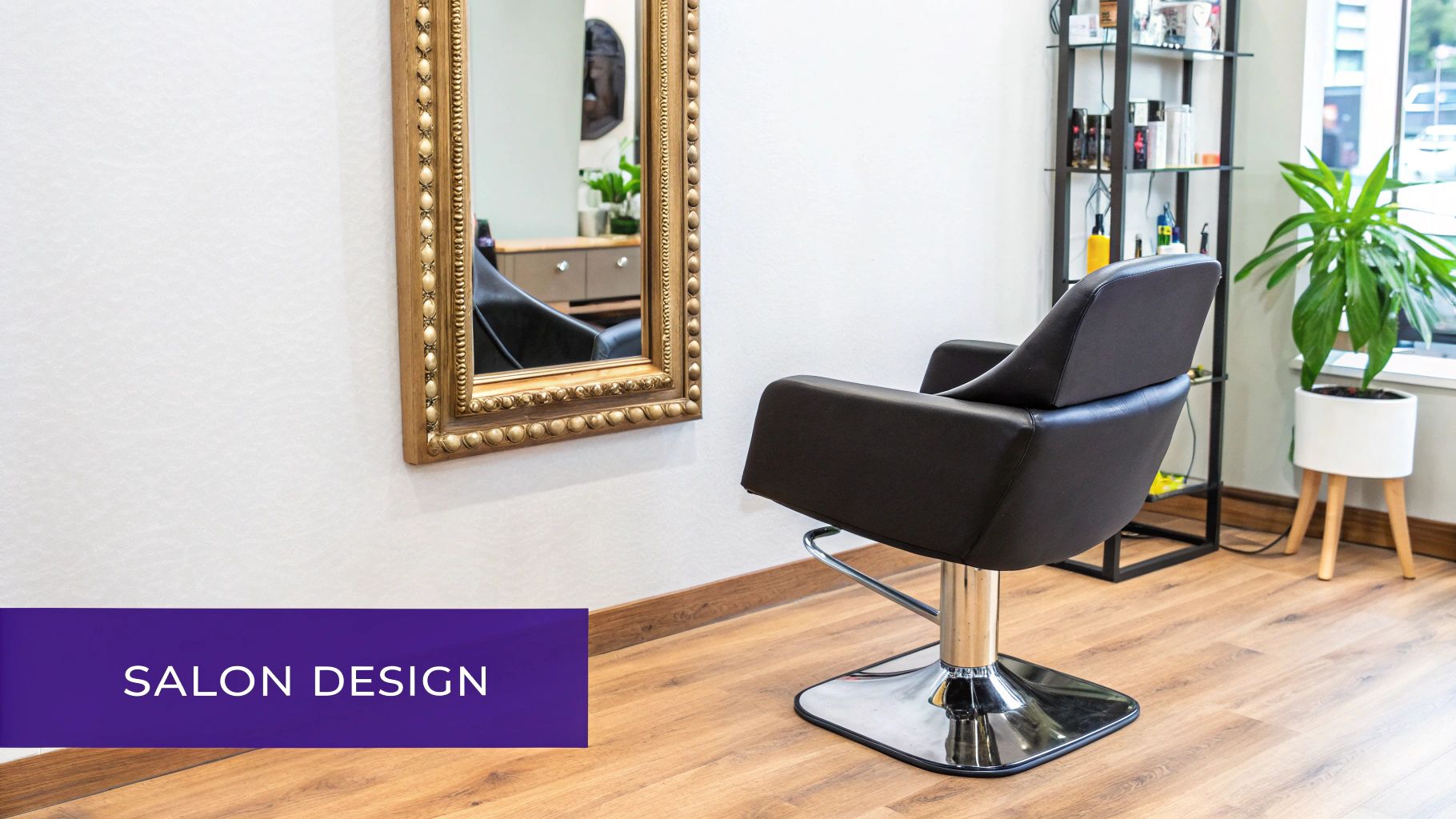
How to Start a Hair Salon: Your Actionable Guide to Success
Starting a hair salon is much more than a passion for hair; it's about building a profitable business from the ground up. Success doesn't start with the first snip of the scissors—it begins with a solid blueprint that maps out your market, services, and financial path long before you open the doors.
Laying the Groundwork: Your Salon's Blueprint for Success
Before the first client walks in, you need a rock-solid plan. This isn’t abstract business theory; it's about the concrete, practical steps that separate thriving salons from those that close within a year. A great idea is one thing, but a viable, profitable business is another. This is where you build the foundation for everything that follows.
First things first: do your homework. Your market research must uncover a real, unfulfilled need in your area. Don't just aim to be "another salon." Pinpoint a specific gap you can fill. For example, a successful urban salon might generate an extra $5,000 per month by offering express 30-minute blowouts targeting lunch-hour professionals. In a family-oriented suburb, you could become the go-to expert for complex color corrections, a high-ticket service that can bring in $300-$500 per client.
What Makes Your Salon Special?
You need to clearly define what sets you apart. This is your unique value proposition (UVP), and it’s the core reason a client will choose you over the salon that's been on their block for a decade.
Think about what your niche could be:
- A Focus on Sustainability: You could build a loyal following by exclusively using eco-friendly, cruelty-free, and organic products. This can attract a clientele willing to pay a 15-20% premium.
- Mastery of a Specialty: Become the expert for curly hair, intricate blonding, or avant-garde color. Specialization allows you to command higher prices and reduces competition.
- An Unforgettable Experience: Justify premium prices by creating a luxurious, spa-like atmosphere. For example, offering a complimentary 5-minute scalp massage with every shampoo can increase client retention by an estimated 25%.
Your brand identity is more than a logo—it’s the promise you make to every person who sits in your chair. A great example of a strong, cohesive brand is Gentleman World, which perfectly captures a classic, refined experience. Every detail, from the decor to the service menu, reinforces that promise.
Building Your Business Plan and Financials
A business plan is your roadmap, not just a document for bankers. It turns your vision into an actionable strategy, detailing your goals and exactly how you plan to reach them. Most critically, it needs to be grounded in realistic financial projections.
Your plan must break down every single startup cost. A small, two-chair salon in a less competitive market might require an initial investment of around $60,000. In contrast, a larger, high-end salon in a prime downtown location could easily command $250,000 or more. The key is to account for everything—from the security deposit on your lease to the very first bottle of developer you buy.
The sample budget below gives you a solid starting point for planning your initial investment. Remember to adjust these figures based on your specific location, salon size, and overall concept.
Sample Startup Cost Breakdown for a Hair Salon
| Expense Category | Estimated Cost Range (USD) |
|---|---|
| Lease Security Deposit & First Month's Rent | $5,000 - $15,000 |
| Salon Build-Out & Renovations | $15,000 - $75,000 |
| Styling Stations, Chairs & Wash Basins | $10,000 - $40,000 |
| Professional Tools & Equipment | $5,000 - $15,000 |
| Initial Product & Retail Inventory | $7,000 - $20,000 |
| Business Licenses & Permits | $500 - $2,000 |
| Point-of-Sale (POS) System & Software | $1,000 - $5,000 |
| Marketing & Grand Opening Promotions | $3,000 - $10,000 |
| Legal & Professional Fees | $1,500 - $5,000 |
| Initial Working Capital (Contingency) | $10,000 - $30,000 |
| Total Estimated Startup Cost | $58,000 - $217,000 |
This breakdown highlights where your money will likely go. As you can see, the physical space—rent and renovations—and the core equipment make up the bulk of the initial investment.

The good news is that you're entering a growing market. The global salon services industry is expected to jump from $232.6 billion in 2025 to nearly $429.8 billion by 2035—that's a compound annual growth rate of 6.5%. This steady expansion, driven by consistent consumer demand, shows that with the right strategy, your new salon has a fantastic opportunity to succeed.
Navigating Finances and Legal Requirements

Alright, this is where the dream starts to feel real. You’ve got the vision, but now it's time to build the official foundation. Tackling finances and legal stuff can feel intimidating, but think of it as setting up the guardrails that will protect you and your business down the road. Let's break it down into clear, manageable pieces.
The very first move you’ll make is deciding on a legal structure. This decision has real-world consequences for your personal liability and how you’ll handle taxes, so it’s worth getting right from day one.
Choosing Your Business Structure
You're mainly looking at three paths: a sole proprietorship, an LLC, or a corporation. A sole proprietorship is the simplest to get going, but there’s a major catch—it offers zero liability protection. This means if your business gets into financial trouble or is sued, your personal assets (like your home or car) are on the line. For most salon owners, that’s just too much risk.
This is why the Limited Liability Company (LLC) is so popular in the salon world. It’s the perfect middle ground. An LLC creates a legal separation between your business and personal finances, giving you that crucial liability protection. It also offers great tax flexibility. You can have it taxed like a sole proprietorship (where profits "pass-through" to your personal return) or, as you grow, elect to be taxed as an S-Corporation, which can lead to significant tax savings.
Then there's the corporation (C-Corp or S-Corp). This structure provides the strongest liability shield but comes with more complex rules, paperwork, and meetings. For a brand-new, single-location salon, an LLC almost always hits that sweet spot of protection and simplicity.
Actionable Takeaway: Go with an LLC. It generally costs between $100 to $500 to file, but that small investment creates a vital legal shield between your business debts and your personal bank account. It's a non-negotiable for any serious entrepreneur and the first step in protecting your personal assets.
Securing Essential Licenses and Permits
With your business entity formed, the next job is getting all the right credentials to operate legally. This isn't just about checking boxes; it’s about demonstrating your commitment to professional standards and public safety, which is the cornerstone of client trust.
Here’s a master list of what you'll almost certainly need:
- State Cosmetology or Barber License: Your personal ticket to practice your craft.
- Salon Business License: The official permission from your city or state to open your doors.
- Certificate of Occupancy: This proves your salon space is up to code and safe for the public.
- Health Department Permit: Expect an inspection. This confirms your sanitation and cleaning protocols meet local health standards.
- Employer Identification Number (EIN): If you plan to hire anyone (and you probably will), you'll need this free tax ID from the IRS.
Funding Your Salon Dream
Now for the money. With your legal paperwork in order, it's time to secure the capital to bring your vision to life. This is where your business plan, especially the financial projections, becomes your most powerful tool.
Many salon owners go the route of traditional bank loans or SBA (Small Business Administration) loans. SBA loans can be a great option for new businesses because the government guarantees a part of the loan, making banks more willing to lend. To get approved, you'll need a polished business plan, a solid personal credit score (aim for 680+), and likely some form of collateral.
Of course, there are other paths. You could seek out private investors or bootstrap the business using your own savings. Bootstrapping gives you total control but also means you're shouldering all the financial risk. Pitching to investors can bring in more cash and valuable connections, but you’ll have to give up a piece of your company.
The good news is you're stepping into a healthy industry. The global hair salon market was valued at USD 52.26 billion in 2024 and is on track to hit USD 59.98 billion by 2033. This consistent growth, driven by people’s ongoing desire to look and feel good, makes a well-planned salon an attractive investment. For a deeper dive, you can review the full market research about hair salon industry trends.
Designing a Salon That Attracts Clients

Long before a client sits in your chair, they experience your salon's space. Your location and interior design are your most powerful, unspoken marketing tools. This isn't just about finding a spot with affordable rent; it's about strategically choosing a location and crafting an environment that pulls people in and makes them feel they've found their new home for hair care.
I've seen it time and again: a salon with incredible stylists in a terrible location will always struggle. On the flip side, a prime spot with a clumsy, inefficient layout will frustrate your team and cheapen the client experience. The goal is to create a seamless, premium journey from the moment someone walks past your window to the second they leave.
Location Is More Than Just a Lease
Choosing your salon's location is fundamentally about aligning your space with your brand. Don't just hunt for any "For Lease" sign. Instead, search for a neighborhood that feels like a natural home for your ideal client.
Are you planning a high-end, luxury color bar? A spot nestled among boutique shops and trendy cafes is a no-brainer. But if your vision is a bustling, family-friendly salon, you’ll want to be closer to suburban schools and shopping centers where your clients already spend their time.
When you're out scouting, here are the non-negotiables to keep in mind:
- Visibility and Foot Traffic: Is the building on a busy street? Will people see it on their daily commute? A corner spot with large windows is often worth a 10-15% higher rent because it’s a free, 24/7 billboard for your business.
- Neighborhood Demographics: Do the people who live and work here match the clients you want to serve? Look into the area's average income, age, and lifestyle.
- Parking and Accessibility: Never underestimate the power of convenient parking. A lack of it can be a deal-breaker for clients, especially those coming in for longer services.
- The Competition: Don't be afraid of being near other salons—sometimes it creates a "beauty district" that draws in more people. But you have to be brutally honest: is your concept strong enough to stand out?
Actionable Takeaway: Spend a full day observing a potential location. Go on a weekday morning, swing by at lunchtime, and check it out on a Saturday. Your own eyes will tell you far more about the neighborhood's true vibe and traffic patterns than any online report ever could.
Designing for a Smart Workflow and Client Comfort
Once you’ve signed that lease, your focus pivots to the interior. A brilliant floor plan does two things at once: it maximizes your revenue per square foot and dramatically improves the experience for both clients and your team. The layout should feel intuitive, so stylists aren't constantly bumping into each other.
An inefficient layout literally costs you money. If a stylist has to walk across the salon to the color dispensary for every client, those wasted minutes add up. Shaving off just 5 minutes per color service through a smarter layout can add up to an extra service per day, per stylist—a potential revenue increase of over $20,000 per year for a single busy stylist. A smart design places high-traffic areas, like your shampoo stations and color mixing bar, in central, easy-to-reach spots.
The client's journey through your salon should feel just as effortless. From a warm and inviting reception desk to a comfy processing lounge and a perfectly lit styling station, every touchpoint should reinforce quality and care. These are the details that allow you to confidently charge premium prices.
Sourcing Equipment That’s Built to Last
Your equipment—from chairs to dryers—is the workhorse of your salon. It needs to be durable, functional, and fit your salon's aesthetic. It's tempting to go for the cheapest options to save cash upfront, but this is a false economy. A styling chair that fails or a shampoo bowl that leaks will cost far more in repairs and lost business than investing in quality from the start.
Here’s how to balance cost and quality:
- Invest in New "Money-Makers": Your styling chairs and backwash units are where clients spend the most time and comfort is critical. Buy these new from reputable brands like Takara Belmont or Collins. You’ll get a warranty, and they’ll match your brand's look.
- Go Refurbished for Secondary Items: You can find fantastic deals on professionally refurbished equipment like hood dryers, reception desks, or retail shelving.
- Prioritize Durability Over Trends: Classic, well-made equipment will outlast any trendy piece. Focus on solid construction and high-grade materials.
The salon industry is a powerhouse, with the European market alone valued at an estimated USD 78.18 billion in 2024. That incredible global strength is built on the foundation of individual salons providing exceptional, in-person experiences—and it all begins with a thoughtfully designed space. You can discover more insights about the global salon services market to get a bigger picture of the industry landscape.
Building Your Dream Team and Service Menu
Your salon's design and location set the stage, but your team and services are the main event. Your stylists are the living, breathing heart of your business—the real reason clients will return time and time again. Getting the right people on board and designing a profitable service menu are two of the most critical moves you'll make.
Assembling Your Salon A-Team
Forget posting a generic "help wanted" ad. Recruiting top talent is like scouting for professionals who truly get your brand's vision. You're not just filling a chair; you're looking for partners who will help you build your dream.
Beyond a killer portfolio, look for stylists with fantastic communication skills and a genuine team spirit. Can they really listen to a client during a consultation? Do they contribute to a positive atmosphere? A supportive, drama-free culture is an incredible asset, and clients feel that energy the second they walk in.
So, where do you find these gems?
- Beauty Schools: Get to know the instructors at local cosmetology schools. They can point you toward their star students. Offering an apprentice or assistant program is a brilliant way to pipeline fresh talent.
- Industry Events: Trade shows and advanced education classes are packed with stylists who are passionate about their craft and serious about their growth. These are your people.
- Social Media: This is a modern-day portfolio. Search local hashtags on Instagram—think #BostonStylist or #NYCHairColorist—to find artists whose work matches your aesthetic.
Structuring Compensation to Incentivize Success
How you pay your team has a massive impact on their motivation and longevity. You've basically got three models to choose from, each with its own pros and cons.
| Compensation Model | How It Works | Best For... |
|---|---|---|
| Commission | Stylists earn a percentage (usually 40-60%) of what they bring in from services and retail. | Building a unified brand where you guide the training, standards, and overall client experience. |
| Booth Rental | Stylists pay you a flat weekly or monthly fee to rent a chair and essentially run their own business within yours. | Owners who prefer predictable income ($500-$1500/month per chair) and want to step back from staff management. |
| Salary/Hourly | Stylists get a guaranteed wage, which can be supplemented with commissions or bonuses. | Salons needing staff for non-service tasks or in states where commission-only pay isn't legal. |
For most new salons focused on a strong, consistent brand, a commission-based structure is the way to go. It directly encourages stylists to build their client base and hustle for the salon's success. A smart approach is a tiered system—a stylist might start at 45% and bump up to 50% after hitting a certain revenue goal. It’s a great way to reward your top performers.
Actionable Takeaway: A common and effective strategy is to start new hires on an hourly wage for a probationary period (e.g., 90 days). Once they've proven their skills and started building a clientele, you can smoothly transition them to a commission structure. This gives the stylist security upfront while you protect your business.
Crafting a Profitable Service Menu
Your service menu isn't just a list of cuts and colors; it's a strategic tool for profitability. To get your pricing right, you have to find the sweet spot between what the market will bear and what your services actually cost to perform. Start by seeing what other comparable salons in your area are charging, but don't just copy them.
You need to calculate the true cost of every single service. Break it down:
- Product Cost: How much color, developer, and shampoo are you using? A high-end balayage service could easily use $25-$40 in product alone.
- Stylist's Time: You must account for the stylist's commission or wages for the entire appointment block.
- Overhead: A little piece of your rent, utilities, and insurance needs to be baked into every service price to ensure you're actually making a profit.
Finally, think carefully about the professional product line you bring in. This isn't just about what you use at the shampoo bowl—it's about creating a retail business that can seriously boost your bottom line. Retail should ideally make up 10-25% of your salon's total revenue. A salon generating $200,000 in services can add an extra $20,000-$50,000 in revenue through smart retailing. Pick a brand that provides excellent education and whose philosophy aligns with yours.
A Modern Marketing Plan to Fill Your Chairs

Let's be honest: an empty salon is every new owner's biggest fear. You've poured your heart, soul, and savings into creating the perfect atmosphere, but none of it matters without clients in the chairs. A modern marketing plan isn't about hoping people find you; it’s a deliberate strategy to build buzz before you even open and keep that momentum rolling.
The trick is to use a smart mix of high-impact, low-cost tactics that resonate with your ideal local clientele. This is about making genuine connections and showing off what makes your salon special, turning first-time visitors into loyal fans.
Let's make sure your appointment book is full from day one.
Build Buzz Before You Open
Your marketing needs to start long before your grand opening. The idea is to cultivate a local following that is counting down the days until they can book an appointment. Right now, a visual platform like Instagram is your most powerful tool.
Start documenting your journey. Post behind-the-scenes photos and videos of the salon taking shape, give sneak peeks of your design, and introduce your stylists. This builds a narrative that people can get invested in.
Real-World Example: A new salon in Austin, Texas, launched its Instagram account three months before opening. They ran a simple contest asking followers to help name their signature balayage service. The winner got the service for free. The result? A ton of local engagement and a fully booked first month before they even unlocked the doors. This strategy cost them about $300 in service value but generated thousands in initial bookings.
Launch Your Digital Storefront
Think of your website as your salon's digital front door—it needs to make an incredible first impression. It must be mobile-friendly, easy to navigate, and showcase your work with stunning, high-quality photos. Most importantly, it has to have a dead-simple online booking system.
Platforms like Cuts.Site are built for this, creating a polished, professional website that integrates seamlessly with your Square booking system. This eliminates any friction for potential clients. When someone finds your salon on Instagram at 10 PM, they should be able to book their appointment right then and there. If they have to remember to call you the next day, you’ve probably lost them. Your online booking page is your 24/7 receptionist.
A well-designed site clearly lays out your services, so clients can easily find what they're looking for. This haircut service page is a perfect example of how clean and straightforward your service menu should look.
Drive Consistent Bookings with Ongoing Marketing
Once you're open, the real work begins. Your focus shifts from building initial buzz to creating a steady, predictable flow of new and returning clients. A multi-channel approach works best.
For the biggest impact, concentrate on these three strategies:
- A Referral Program That Actually Works: Your happiest clients are your best salespeople. Offer a compelling incentive, like 20% off their next service for both them and the friend they refer. A referred client has a 16% higher lifetime value than a non-referred one.
- Geo-Targeted Social Media Ads: Don't just "boost post." Use the ad managers on Facebook and Instagram to run highly targeted campaigns aimed at people within a 5-10 mile radius of your salon. You can even layer in interests like "hair care" or "beauty salons." Even a small budget of $10-$20 per day can bring in a surprising number of new clients.
- Email and SMS Marketing: Collect emails and phone numbers during booking. Send a "thank you" message after their first visit and a friendly reminder a few weeks later when they're due for their next appointment. This simple automation can boost repeat business by over 30%.
To get started, you need to decide where to put your time and money first. Not all marketing channels are created equal, especially when you're just starting out.
Marketing Channel ROI Comparison for New Salons
This table breaks down common marketing channels. Use it to prioritize your budget and efforts to get your first wave of clients through the door.
| Marketing Channel | Typical Cost | Time Investment | Potential ROI |
|---|---|---|---|
| Client Referral Program | Low (Discount-based) | Low (Ongoing) | Very High |
| Local Social Media Ads | Medium ($150-$500/mo) | Medium (Setup & monitoring) | High |
| Email/SMS Marketing | Low (Software costs) | Low (Automation) | Medium-High |
| Content Marketing (Blog/Video) | Low (Time-based) | High (Consistent effort) | Medium (Long-term) |
By combining these strategies, you’re not just marketing—you’re building a powerful engine that will fill your chairs and create the foundation for sustainable, long-term growth.
Answering Your Top Salon Startup Questions
Starting a hair salon is an exciting venture, but it’s natural to have questions swirling around. As you turn your dream into a concrete plan, certain concerns come up again and again. Let's tackle the most common questions from aspiring salon owners with straight-up, practical answers.
https://www.youtube.com/embed/WeaAgP13DhA
How Much Does It Really Cost to Start a Small Hair Salon?
The honest answer? It varies wildly depending on your city, your vision, and the state of the property you lease. But you absolutely need a realistic number to aim for.
For a modest, two or three-chair salon in a mid-sized market, you should budget somewhere between $60,000 and $150,000. This figure covers essentials like the security deposit and first month's rent, basic renovations and plumbing, your core equipment (styling stations, chairs, washbowls), initial product and color inventory, and all the necessary licenses.
If you're dreaming of a high-end salon in a prime spot in a city like New York or Los Angeles, that number can easily climb past $250,000. The real key is to build a detailed, line-item budget from the very beginning.
What Is the Most Common Reason New Salons Fail?
Overwhelmingly, the number one killer of new salons is undercapitalization and poor financial management. Many passionate owners pour everything into a budget to get the doors open, but they completely forget about the lean months that inevitably follow.
You absolutely need a safety net. I tell every new owner to have at least six months of operating expenses stashed away in a reserve fund. This cash buffer is what lets you cover rent, payroll, and utilities while you're still building your client list. Without it, a few slow weeks can put you in a corner you can't get out of.
Coming in at a close second is a weak brand identity combined with lackluster marketing. If you can't clearly explain what makes your salon special and get that message in front of the right people, you'll struggle to fill your chairs.
Actionable Takeaway: A successful launch hinges on financial preparedness. The initial investment gets the doors open, but it's the working capital that keeps them open. Plan for the slow days so you can survive long enough to enjoy the busy ones.
Should I Choose Booth Rental or Commission for My Stylists?
This is a foundational decision that will shape your salon's entire culture and business model. There isn't a single "right" answer, but each path leads to a very different kind of business.
Commission (or Salary): This model gives you the most control. You set the service standards, dictate the client experience, and build a cohesive team under one unified brand. If your goal is to create a specific, premium salon experience where every client gets the same high level of service, this is your best bet. You are the employer, and your stylists are your employees.
Booth Rental: This approach gives you more predictable, stable income. Stylists pay you a flat weekly or monthly fee for their space ($200-$400/week is common), which means fewer management headaches for you. The trade-off is control. Your renters are independent contractors running their own businesses within your walls. They set their own prices, hours, and service styles, which can dilute your brand.
For new owners focused on building a powerful brand from scratch, the commission model is almost always the better choice. It aligns everyone’s goals toward the salon's collective success.
How Long Does It Take for a New Hair Salon to Become Profitable?
Patience is a non-negotiable trait in the salon business. On average, you can expect a well-managed new salon to reach profitability—where your monthly revenue is consistently higher than your expenses—within 18 to 24 months.
However, you can speed up that timeline. A salon that launches with a powerful pre-opening marketing campaign, has stylists who bring an established clientele with them, and keeps a tight grip on operational costs can potentially break even in as little as 6 to 12 months.
That first year is often a grind. The focus is on building momentum and hitting your break-even point. Don't get discouraged if you're not seeing huge profits right away. Concentrate on giving exceptional service, marketing smartly, and building a loyal following of repeat clients. That’s the real formula for long-term financial success when you start a hair salon.
Ready to create a professional online presence for your shop that syncs perfectly with your booking system? Cuts.Site builds you a sleek, modern bio site that pulls all your services, barbers, and location details directly from your Square account. It's the effortless way to impress new clients and make booking simple. Get started with Cuts.Site today.




